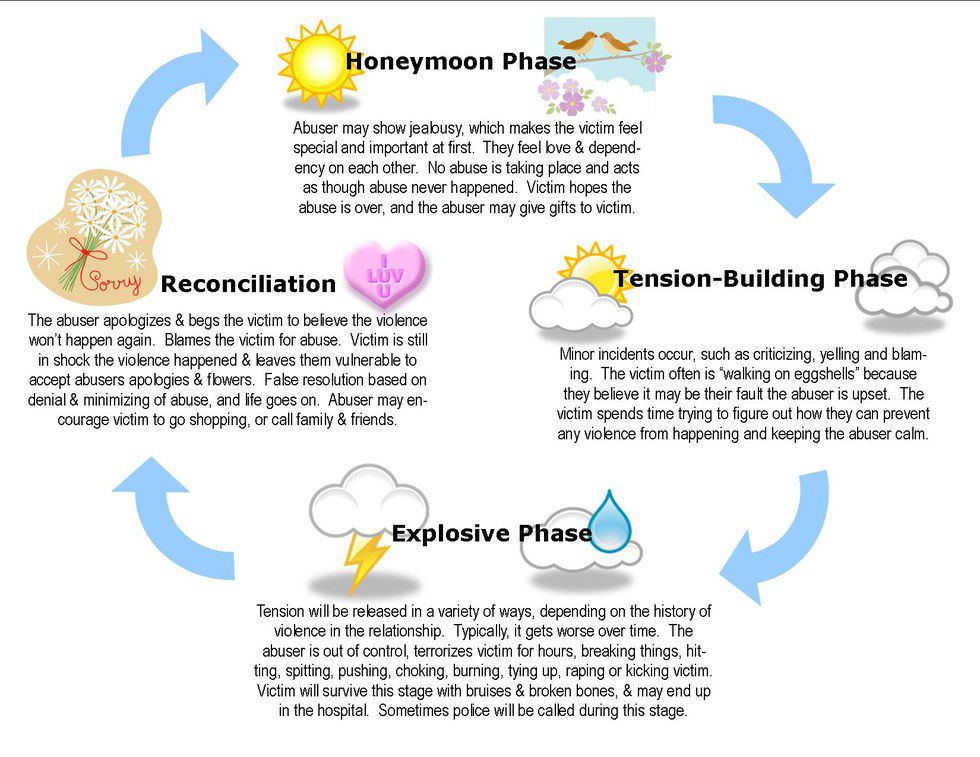October is National Domestic Violence Awareness month, which means it’s time to air the dirty laundry so seldom talked about: domestic violence and the facts. Prior to giving you the misconstrued facts, I’d like to disclose that domestic violence is a cycle. It is one that often goes un-noticed and more commonly than not it can seem invisible to the abusee.
Fist of all, what is domestic abuse? Domestic abuse is not always easy to catch. It can look different in each person’s situation whether it be, psychical, emotional, sexual or otherwise, domestic abuse is commonly seen with a power system. According to The National Domestic Violence Hotline, “the abusive partner does many different kinds of things to have more power and control over their partners.” Some of the most common signs of an abuser can be seen as:
- Telling you that you can never do anything right
- Showing jealousy of your friends and time spent away
- Keeping you or discouraging you from seeing friends or family members
- Embarrassing or shaming you with put-downs
- Controlling every penny spent in the household
- Taking your money or refusing to give you money for expenses
- Looking at you or acting in ways that scare you
- Controlling who you see, where you go, or what you do
- Preventing you from making your own decisions
It is important to note that abuse is a cycle that is more violent than most people suspect and that when trying to help someone who is in an abusive situation, one must know what sites to visit in order to allow for SAFE guidance and help. Bellow I will list a multitude of phone numbers and safe sites that allow for fast and easy termination.
Knowing the abuse cycle:
This cycle is the most commonly known cycle for abuse, and is often the easiest to spot. In abuse, there are the four main phases: Honeymoon, Tension-Building (micro-aggressions), Explosion, and Reconciliation. Within this cycle, it is important to note that this can happen outside of romantic relationships. It can happen in friendship, relationships, familial situation and many other instances. Abuse as a cycle, is often recognizable with physical evidence, but some of the most dangerous abusive situations occurs when it is emotional abuse. It can be as easy to notice as a shift in behavior, whether that be physical or mental seclusion. Either way, this cycle can be a somewhat simple indication of whether or not abuse is occurring.
Knowing the facts:
- Every 9 seconds in the US, a woman is assaulted or beaten.
- On average, nearly 20 people per minute are physically abused by an intimate partner in the United States. During one year, this equates to more than 10 million women and men.
- 1 in 3 women and 1 in 4 men have been victims of [some form of] physical violence by an intimate partner within their lifetime.
- 1 in 5 women and 1 in 7 men have been victims of severe physical violence by an intimate partner in their lifetime.
- 1 in 7 women and 1 in 18 men have been stalked by an intimate partner during their lifetime to the point in which they felt very fearful or believed that they or someone close to them would be harmed or killed.
- On a typical day, there are more than 20,000 phone calls placed to domestic violence hotlines nationwide.
- The presence of a gun in a domestic violence situation increases the risk of homicide by 500%.
- Intimate partner violence accounts for 15% of all violent crime.
- Women between the ages of 18-24 are most commonly abused by an intimate partner.
- 19% of domestic violence involves a weapon.
- Domestic victimization is correlated with a higher rate of depression and suicidal behavior.
- Only 34% of people who are injured by intimate partners receive medical care for their injuries.
- 1 in 15 children are exposed to intimate partner violence each year, and 90% of these children are eyewitnesses to this violence
- Victims of intimate partner violence lose a total of 8.0 million days of paid work each year
- The cost of intimate partner violence exceeds $8.3 billion per year.
- Between 21-60% of victims of intimate partner violence lose their jobs due to reasons stemming from the abuse.
- Between 2003 and 2008, 142 women were murdered in their workplace by their abuser, 78% of women killed in the workplace during this timeframe.
- 72% of all murder-suicides involve an intimate partner; 94% of the victims of these murder suicides are female.
How to help:
Helping someone who is a victim of domestic violence can be as easy as being there for them. Often times domestic abuse, as stated above, can be invisible to the abusee and helping can be as easy as being by a victim’s side and reminding them of their options. The safety of the abusee is always the most important, so before contacting authorities advice should be sought after by one of the following hotlines or websites:
24 Hour National Hotline (available in English and Spanish)
~1-800-799-SAFE (7233)
~1-800-787-3224
http://www.ncadv.org/ (National)http://www.thehotline.org/ (National)
http://www.pcadv.org/ (Pennsylvania) NO ESCAPE BUTTON
https://rainn.org/ (National) NO ESCAPE BUTTON
http://www.ncjfcj.org/ (National) NO ESCAPE BUTTON
http://www.immigrantwomennetwork.org/ (Supports Immigrant Women)
*Facts and Information via The National Domestic Violence Hotline*




















